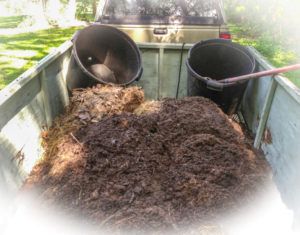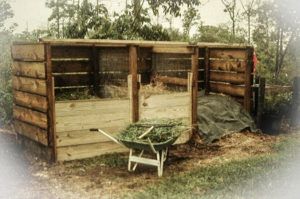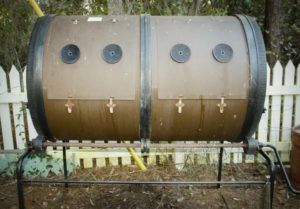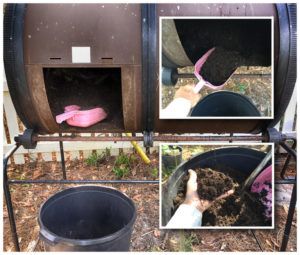
Composting is the way to feed the soil and let the soil feed the plants
![]()
The cornerstone of every organic garden is the soil and the key to good soil is compost, the organic matter that has been decomposed and re-purposed as an effective soil amendment and fertilizer.
Soil plays a very important role in the garden by acting, not only as a stabilizer for your plant but as a reservoir for water and dissolved fertilizer and, like your children or pets, it needs to be nourished to keep it thriving. Healthy soil is made up of 45% mineral, 25% air, 25% water, and 5% organic material. Compost contains an abundance of bacteria and organisms that are constantly working to break down natural organic matter and fertilizers making them available, in solution, to your herbs and vegetables.
Florida soils are varied. On one end we have clay…flat particles that stick up on one another forming a dense soil that is prone to holding too much water and on the other end we have Florida sand, either coarse or fine, the course with little water holding capacity and the fine that has water flowing along the top and running off. In the middle we have what is often classified as loam…a balanced combination of clay, sand, and organic matter…this is what we are looking for, often referred to as a well-drained, sandy loam. I talk more about soil in my article ‘Growing Herbs in Florida’…in this article I will discuss compost.
How to Begin making Compost…
Compost requires a few things…Organic matter: Carbon-rich items such as straw/hay, brown fall leaves, old flowers, cardboard or newspapers and very small stems of plants and Nitrogen rich items such as vegetable/plant-based kitchen scraps, grass clippings and animal manures from non-carnivorous critters…cows, horses, chickens, sheep, goats, and rabbits are popular.  We use Chicken, horse, cow, and when we can get it from friends, rabbit manure.
We use Chicken, horse, cow, and when we can get it from friends, rabbit manure.
We, as many gardeners and farmers do, keep a kitchen scrap bucket next to the sink where we clean our dishes, scrape our leftover scraps into this and then bring it outside to where we ‘make our compost’.
Compost can be made in several ways using piles, layers, bins, and tumblers. What any of these methods require is the organic matter mentioned above, airflow, and moisture. I like to think of compost as a living ‘pet’. My goal is to raise bacteria, and plenty of it, to break down the organic matter into the black gold we know as compost. Bacteria are alive and so like most living things, they need a food source, water, and air.
When using the pile or layer methods try to maintain minimum dimensions of 3 x 3 x 3.
 This size offers enough mass for the decomposition of the materials, Alternate the ‘ingredients’ of your pile and try to maintain a 3 to 1 ratio of the ‘carbon’ materials to the nitrogen materials. Lightly water each layer as the pile or layer is put together. Once completed, try to protect the area from drying out or from getting too much water by putting a layer of straw around the pile or bed and covering it with a tarp if you are experiencing a lot of rainy weather. After a week or so, the pile should begin to slowly shrink down as the materials decompose…it is then that I turn the pile with a garden fork and expose some of the inner materials to the outside and the outside in to bring in the fresh air, lightly water if necessary and cover again, repeating this process over the course of several weeks as the materials transform into compost.
This size offers enough mass for the decomposition of the materials, Alternate the ‘ingredients’ of your pile and try to maintain a 3 to 1 ratio of the ‘carbon’ materials to the nitrogen materials. Lightly water each layer as the pile or layer is put together. Once completed, try to protect the area from drying out or from getting too much water by putting a layer of straw around the pile or bed and covering it with a tarp if you are experiencing a lot of rainy weather. After a week or so, the pile should begin to slowly shrink down as the materials decompose…it is then that I turn the pile with a garden fork and expose some of the inner materials to the outside and the outside in to bring in the fresh air, lightly water if necessary and cover again, repeating this process over the course of several weeks as the materials transform into compost.

Composting with tumblers makes the process of decomposing quite easy. We have a large Mantis, two bin tumbler that we add our ingredients to and in the process of turning it, all the materials are constantly exposed to fresh air and moisture, without the need for covers or the labor required to turn larger piles.
 Compost is ready when it actually looks like rich soil with organic matter, alive with bacteria and often earthworms. It is ready to be incorporated into the garden soil!
Compost is ready when it actually looks like rich soil with organic matter, alive with bacteria and often earthworms. It is ready to be incorporated into the garden soil!
Maintaining healthy soil is a must for successful gardening. Many folks add packaged fertilizers to the garden that do provide nutrients to the plants, however, do little to improve the structure and vibrance of the soil. Compost usually has a neutral ph and acts as a great balance in providing nutrients keeping the soil from becoming too alkaline or too acidic. With the addition of compost, the organic matter of the soil is increased as is the beneficial bacteria level and healthy soil will produce healthy plants.
![]()

